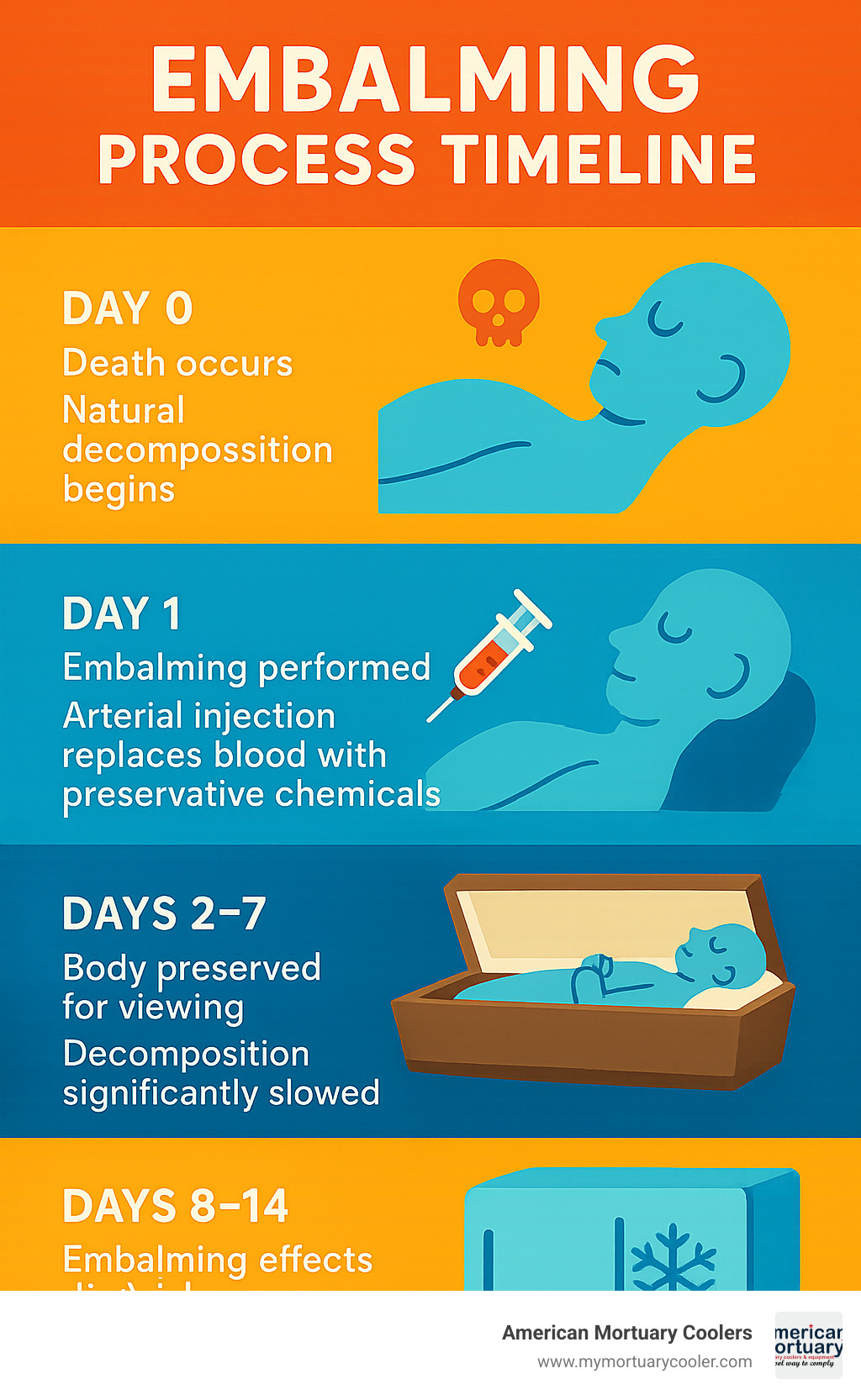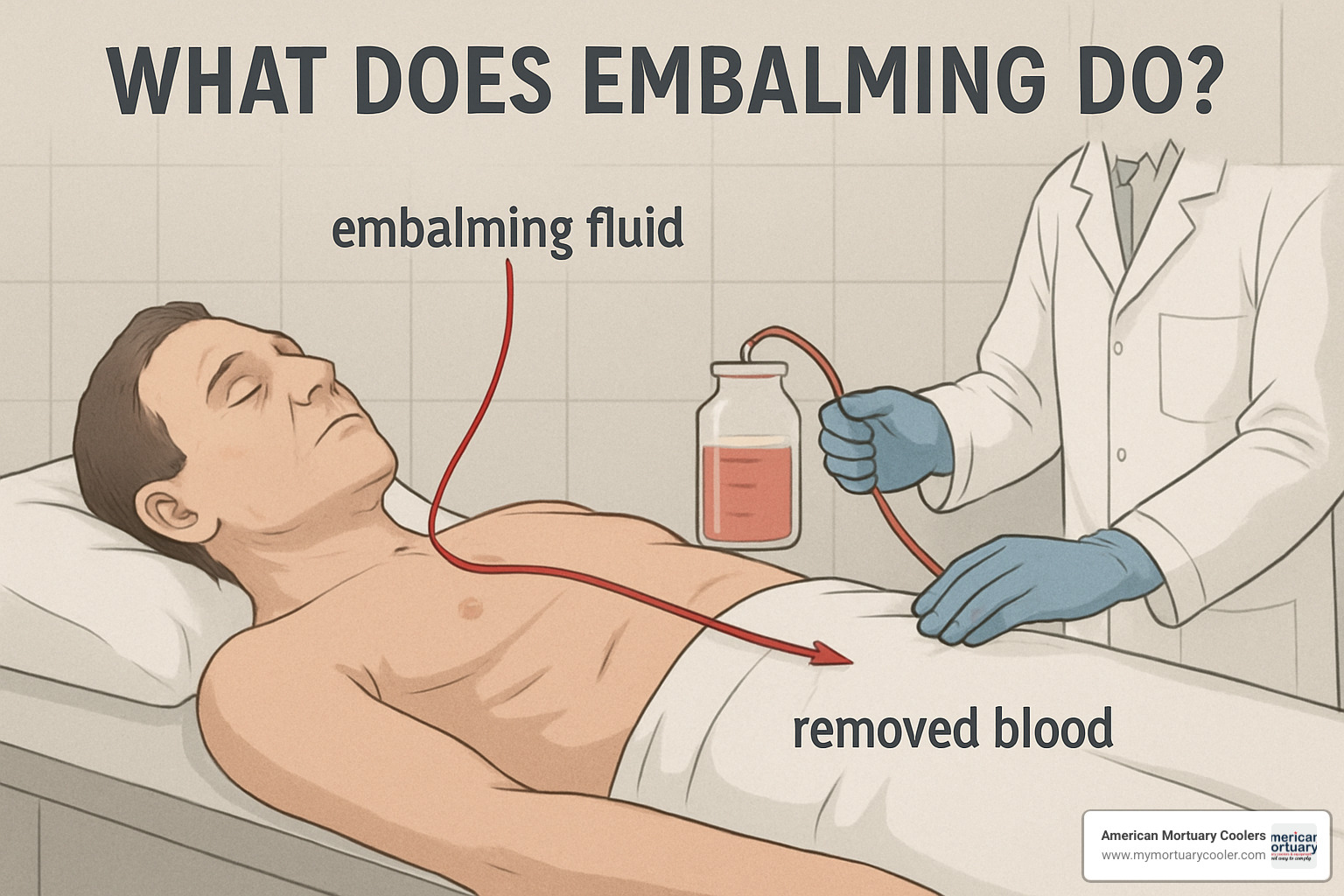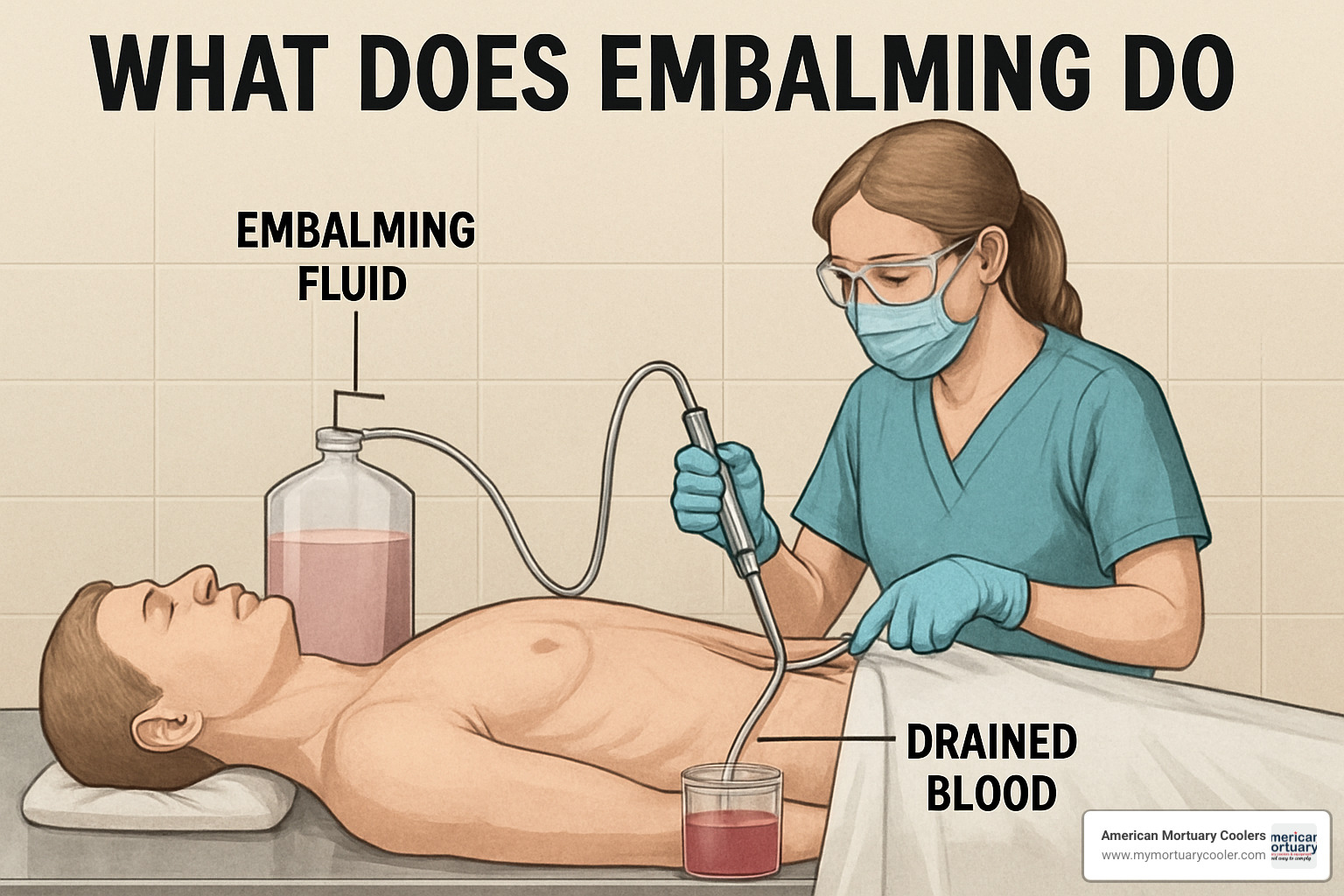Understanding What Modern Embalming Accomplishes
What does embalming do to prepare human remains for viewing and final disposition? At its core, embalming is a preservation process that:
- Sanitizes the body by killing harmful bacteria and pathogens
- Preserves tissues temporarily by slowing decomposition for 3-10 days
- Restores natural appearance through cosmetic preparation
- Enables open-casket viewings and safe transport of remains
This ancient practice, refined with modern chemistry, serves multiple purposes beyond simple preservation. While Egyptian mummification aimed for eternal preservation, today's embalming focuses on temporary delay of decomposition to support funeral customs and public health requirements.
The process involves replacing blood with chemical solutions - typically containing formaldehyde - through arterial injection. This creates the tissue firmness and natural coloring families expect during viewings. According to research, approximately 3 gallons of embalming fluid circulate through the body during a typical 2-hour procedure.
I'm Mortuary Cooler, a national-level mortuary equipment supplier with extensive experience helping funeral homes understand what does embalming do and how proper refrigeration supports the entire process.

Basic what does embalming do terms:
What Does Embalming Do? Understanding the Basics
When families ask "what does embalming do", they're looking for clear answers during a difficult time. Embalming serves three essential purposes: sanitation, preservation, and restoration.
Sanitation protects everyone involved by killing harmful bacteria and pathogens that could pose health risks to funeral home staff and families. Preservation gives families precious time - usually a few days to weeks - allowing for funeral planning and distant relatives to travel. Restoration addresses what matters most to grieving hearts by bringing back natural skin color and firmness, helping loved ones look peaceful and familiar.
The main technique involves arterial injection, where embalming fluid flows through major arteries while blood drains from veins. This is followed by cavity treatment, where embalmers use a trocar to remove fluids from internal organs and inject concentrated preservatives.
Key Functions: What Does Embalming Do to the Body?
At the microscopic level, what does embalming do involves formaldehyde cross-linking - formaldehyde molecules grab onto proteins in cells and link them together like a protective net. This cell fixation process is similar to tanning leather, creating tissue firmness families notice during viewings.
Color restoration happens through multiple pathways. Embalming fluids contain dyes that give skin a healthier appearance while preventing the color changes that come with decomposition.
Scientific Perspective on What Does Embalming Do
Embalming disrupts decomposition through enzyme inhibition and bacterial control. The chemical environment becomes hostile to bacteria responsible for decomposition. Research shows one ounce of pure formaldehyde can preserve about 37 pounds of tissue.
Scientific research on modern preservation reveals how today's techniques maximize effectiveness while minimizing chemical exposure risks. Temperature makes a huge difference - bodies kept cooler maintain their embalmed condition much longer, which is why many funeral homes combine embalming with refrigeration.
Inside the Embalming Process: Step-by-Step

When families wonder what does embalming do behind closed doors, they're asking about a careful, respectful process that typically takes 2-4 hours. The journey begins with thorough preparation - washing and disinfecting the body while treating it with dignity.
Setting features involves closing the eyes using special plastic caps and carefully positioning the mouth to preserve each person's unique expression. The core preservation work happens during arterial embalming, where embalmers make small incisions to access major blood vessels and pump preservative fluid at controlled pressure.
Cavity treatment addresses what arterial embalming can't reach, using a trocar to remove fluids from internal organs and inject concentrated cavity fluid. The process concludes with cosmetic work and dressing - styling hair, applying mortuary cosmetics, and positioning hands naturally.
Step-by-Step Answer to What Does Embalming Do Inside the Body
Fluid flow follows the body's natural circulation highways. The embalming machine becomes a temporary heart, pumping preservative solution through arteries while veins drain blood. Dye indicators help embalmers track progress, showing when preservation fluid has reached different body areas.
Cavity chemicals work differently than arterial fluids, using higher concentrations injected directly into organ spaces. This dual approach ensures thorough preservation of both vascular tissues and internal organs.
For deeper technical knowledge, see our A Practical Guide to Mortuary Embalming and How It Works.
Tools, Tables & Fluids Used
Modern embalming uses specialized equipment including stainless steel embalming tables with integrated drainage, trocars for cavity treatment, and embalming machines that control fluid pressure precisely. Chemical formulations include surfactants for tissue penetration and dyes for progress indication.
Our guide Everything You Need to Know About Embalming Fluid explains fluid selection and safety considerations.

Why Embalm? Benefits, Drawbacks, and How Long It Lasts
When families ask "what does embalming do" for their situation, the answer depends on their unique needs. Most choose embalming for viewing comfort - seeing their loved one appear peaceful helps families begin their grief journey.
Funeral delays create another scenario where embalming becomes essential, providing preservation while relatives travel or scheduling conflicts are resolved. International repatriation makes embalming legally required in most situations, and infectious disease control serves public health functions.
Cost factors vary significantly - typical embalming runs $500-$1,200. However, environmental concerns have grown as people understand formaldehyde's ecological impact, and green burial compatibility creates limitations since most natural burial grounds prohibit embalmed remains.
Typical preservation lasts 3-10 days under normal conditions, though refrigeration can extend this considerably.
| Preservation Method | Duration | Cost Range | Environmental Impact |
|---|---|---|---|
| Embalming | 3-10 days | $500-$1,200 | High (chemicals) |
| Refrigeration | 1-2 weeks | $200-$500 | Low |
| Dry Ice | 24-48 hours | $100-$300 | Medium (CO2) |
Benefits Families Cite
The peaceful appearance achieved through embalming consistently tops family satisfaction surveys. Acceptance of death often comes easier when families can see their loved one in a dignified state, and extended travel time becomes crucial for scattered modern families.
Drawbacks & Environmental Impact
Formaldehyde exposure concerns have grown as research reveals potential health risks. Groundwater contamination represents a legitimate environmental issue, and eco-burial limitations force difficult choices for environmentally conscious families. Cost considerations make embalming prohibitive for some families during an already expensive time.
Laws, Culture & Ecology: When Embalming Is Required—or Not
The legal landscape around embalming creates a patchwork of requirements. What does embalming do legally depends on where you live and your circumstances. Federal law actually prohibits funeral homes from claiming embalming is required unless specific laws truly mandate it.
Repatriation laws represent one situation where embalming becomes genuinely required for international transport. U.K. rules differ - while popular, embalming is rarely legally required. Many U.S. states have 24-hour refrigeration mandates as alternatives to embalming.
Cultural preferences often override legal requirements, and eco-legislation increasingly affects embalming practices. The complexity increases when religious beliefs intersect with legal requirements.
For deeper understanding, see The Science of Embalming: Chemistry, Microbiology, and Anatomy in Modern Preservation.
Religious & Cultural Views on Embalming
Islamic traditions generally prohibit embalming except when legally required for repatriation. Orthodox Jewish communities often share similar prohibitions, though practices vary. Hindu traditions typically discourage embalming while preferring cremation. Christian denominations vary widely, with most leaving the decision to families.
Ceremonial washing practices in various cultures create complex situations that may be incompatible with embalming chemicals. Autopsy effects complicate religious requirements when legally mandated autopsies occur.
Eco-Friendly Trends & Green Alternatives
The natural burial movement has gained momentum as environmental consciousness grows. Formaldehyde-free embalming fluids represent the industry's response to environmental concerns, using different chemical formulations with reduced environmental impact.
Refrigeration technology improvements have made non-embalming preservation viable for extended periods. Modern mortuary coolers can maintain remains for weeks without chemical preservation, supporting both environmental concerns and religious requirements.
Alternatives to Embalming & Emerging Green Options
When families ask what does embalming do compared to other preservation methods, they have several alternatives. Refrigeration stands as the most practical alternative, maintaining remains at optimal temperatures for weeks without chemical preservation.
At American Mortuary Coolers, we've witnessed growing demand for high-quality refrigeration systems as families seek alternatives to traditional embalming. Our custom mortuary coolers provide reliable preservation that meets both regulatory requirements and family needs.
Dry ice preservation works for short-term situations lasting 24-48 hours. Alkaline hydrolysis or "water cremation" represents an emerging green alternative using heated alkaline solution. Body composting transforms remains into nutrient-rich soil, while whole-body donation eliminates the need for family-directed preservation entirely.
Comparing Preservation Methods
Cost differences are substantial. Embalming runs $500-$1,200, refrigeration costs $200-$500, and dry ice ranges $100-$300. Time limitations vary - embalming provides 3-10 days, refrigeration extends for weeks, while dry ice offers only 1-2 days.
Environmental footprint considerations increasingly influence choices. Embalming has the highest impact due to chemical use, while refrigeration and alternatives have minimal long-term effects. Family experience differs significantly - embalming provides the most natural appearance for viewing.
Resources for Learning
Professional development continues evolving as new methods gain acceptance. For comprehensive training information, see How to Learn Embalming: 5 Methods That Guarantee Results.
Equipment knowledge becomes crucial as funeral homes expand services. Our guide What is an Embalming Table? provides essential information for equipment considerations.
Frequently Asked Questions about What Does Embalming Do
How long does embalming preserve a body?
When families ask what does embalming do in terms of preservation time, the answer is typically one week under normal conditions, extending to several weeks with proper refrigeration. Modern funeral embalming isn't designed for long-term preservation.
Several factors influence duration: chemical concentration, body condition at death, storage conditions, and embalming quality. Cool temperatures and low humidity extend preservation significantly, which is why many funeral homes combine embalming with refrigeration.
Is embalming required by law everywhere?
What does embalming do legally is more limited than many think. Federal law actually prohibits funeral homes from claiming embalming is required unless specific legal mandates exist. However, international repatriation typically requires embalming, and contagious diseases sometimes trigger requirements.
Most states offer refrigeration as an alternative when preservation is needed, giving families choices while meeting legal requirements.
Can we have a viewing without embalming?
Absolutely! Many families hold meaningful viewings without embalming. Timing becomes crucial - these need to happen within 24-48 hours, though refrigeration can extend this window. Appearance expectations need adjustment, but basic preparation can still create dignity and comfort for viewing families.
Conclusion
Understanding what does embalming do empowers families to make thoughtful decisions during challenging times. This preservation process sanitizes remains, temporarily slows decomposition, and restores natural appearance so families can find peace in their final memories.
The choice to embalm isn't one-size-fits-all. Your family's values matter - whether honoring religious traditions, protecting the environment, managing costs, or having time for distant relatives to say goodbye. Some families find deep comfort in seeing their loved one appear peaceful, while others prefer environmentally gentle alternatives.
At American Mortuary Coolers, we've spent years helping funeral homes across Tennessee and the contiguous 48 states serve families with dignity and options. Whether families choose traditional embalming, modern refrigeration preservation, or emerging green alternatives, having the right equipment makes all the difference.
The funeral industry continues evolving as families become more environmentally conscious. What does embalming do remains important, but families now can align choices with their deepest values - traditional preservation, natural burial, or innovative alternatives like alkaline hydrolysis.
What matters most is ensuring every family has complete, honest information about their options. No one should feel pressured into choices that don't feel right. Whether exploring embalming, considering refrigeration alternatives, or researching green burial possibilities, you deserve clear answers without sales pressure.
For comprehensive information about mortuary equipment solutions that support every preservation method, visit More info about mortuary solutions. We're here to help funeral professionals serve your family with the respect, dignity, and genuine options you deserve.

















